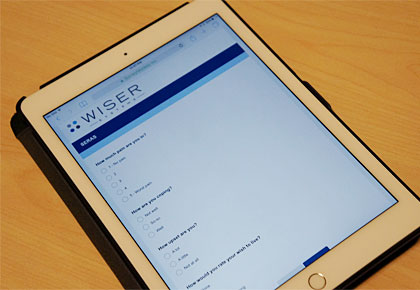Climbing suicide rates over the past ten years have prompted three Joint Commission Sentinel Event Alerts – the most recent in February 2016 – urging health care organizations to step up screening and detection of those individuals most at risk.

UVM researchers developed a tablet-based suicide risk assessment tool designed to replicate the thinking of an experienced psychiatrist in the evaluation of near term suicide risk in the hospital setting. (Photo: COM Design & Photography)
Climbing suicide rates over the past ten years have prompted three Joint Commission Sentinel Event Alerts – the most recent in February 2016 – urging health care organizations to step up screening and detection of those individuals most at risk. But due to a shortage of both time and psychiatry staff, complying with this mandate presents a challenge. A tablet-based suicide risk assessment tool developed by researchers at the University of Vermont may provide clinicians in the hospital with a solution.
Results from a study of this promising tool’s effectiveness are reported in the June 7 Online First edition of the Journal of Clinical Psychiatry.
According to the Centers for Disease Control and Prevention, suicide ranks among the top four leading causes of death in individuals between the ages of 10 and 54. Suicide claims 25 percent more lives annually than motor vehicle accidents.
“The problem of suicide in the U.S. has ramped up and is becoming a significant public health issue, and in some sectors – like the military – is reaching epidemic proportions,” says lead study author Isabelle Desjardins, M.D., an associate professor of psychiatry and medical director of inpatient psychiatry at the University of Vermont. She says that replicating the psychiatrist’s critical thinking process in assessing near term risk – which she describes as multidimensional – has been a critical missing piece in the available tools used to date.
Between 2012 and 2014, Desjardins and her University of Vermont colleagues conducted a three-phase study to evaluate the performance of a tablet-based suicide risk assessment tool they had co-developed in the emergency department (ED) setting.
“We hypothesized that the tool would predict the assessment of experienced psychiatrists in evaluating a patient’s risk of committing suicide in the next 72 hours in the hospital,” write the authors.
By conducting a consensus panel with experts in the field, the researchers developed a tool designed to replicate the thinking of an experienced psychiatrist in the evaluation of near term suicide risk. They then tested this model in three samples of 429 participants using a novel neural network-based algorithm to assess suicide risk in emergency department and medical inpatients. The model was compared to expert psychiatric assessment of near term risk.
The tablet-based tool performed at a remarkably high level. For levels of suicide risk, the model predicted the psychiatrists’ assessment at between 91 and 94 percent, but did so in a fraction of the time (less than 1 minute). Patients reported that the tool was easy to complete.
“We’ve demonstrated for the first time that a simple, quick model can accurately predict a psychiatrist’s assessment of near-term risk for suicide,” says Desjardins. “To have a tool to standardize risk assessment efficiently is the first step towards meeting the Joint Commission mandate. Perhaps most importantly, this tool can be most helpful in identifying individuals at risk by augmenting clinical decision support in settings where with scarce psychiatry resources.”